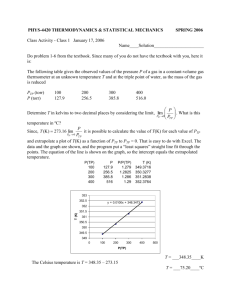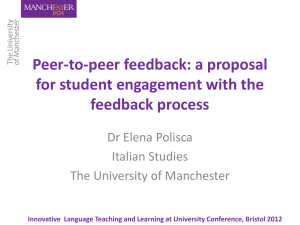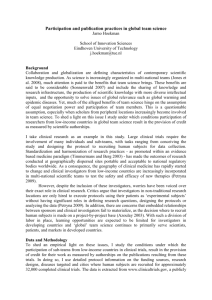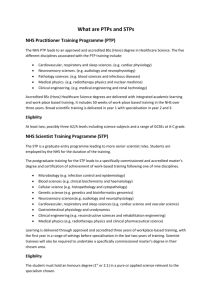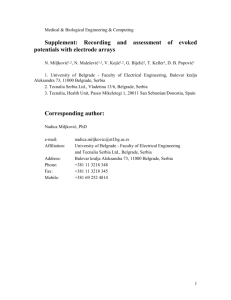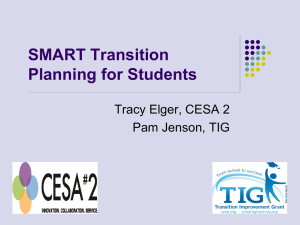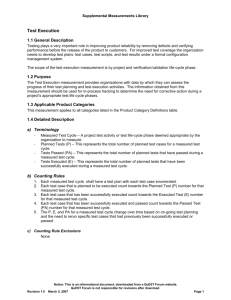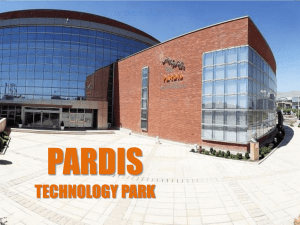MS Word version - Department of Civil Engineering
advertisement
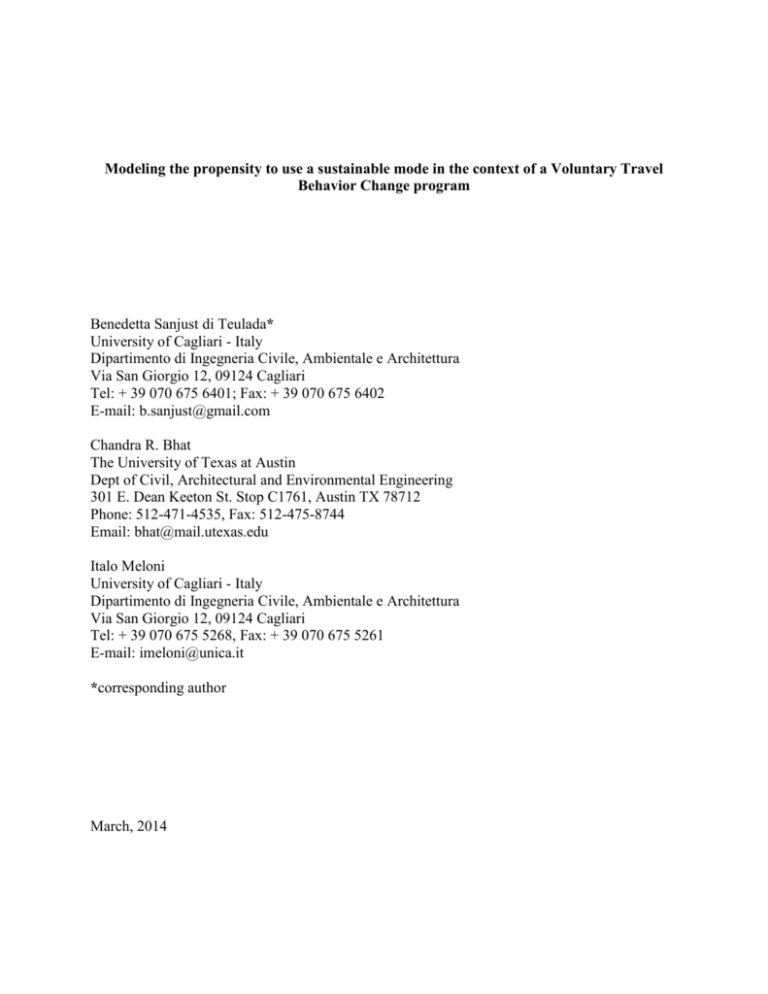
Modeling the propensity to use a sustainable mode in the context of a Voluntary Travel Behavior Change program Benedetta Sanjust di Teulada* University of Cagliari - Italy Dipartimento di Ingegneria Civile, Ambientale e Architettura Via San Giorgio 12, 09124 Cagliari Tel: + 39 070 675 6401; Fax: + 39 070 675 6402 E-mail: b.sanjust@gmail.com Chandra R. Bhat The University of Texas at Austin Dept of Civil, Architectural and Environmental Engineering 301 E. Dean Keeton St. Stop C1761, Austin TX 78712 Phone: 512-471-4535, Fax: 512-475-8744 Email: bhat@mail.utexas.edu Italo Meloni University of Cagliari - Italy Dipartimento di Ingegneria Civile, Ambientale e Architettura Via San Giorgio 12, 09124 Cagliari Tel: + 39 070 675 5268, Fax: + 39 070 675 5261 E-mail: imeloni@unica.it *corresponding author March, 2014 2 Sanjust di Teulada, Bhat, and Meloni ABSTRACT In the current paper, we propose a modeling approach to evaluate the effect of a Personalized Travel Plan on a sustainable mode choice. A Panel Binary Probit is estimated using the Composite Marginal Likelihood (CML) estimation approach. The formulation models the choice of using a light rail service (vs. the choice of not using it), using daily individual panel observations, collected in the context of a Voluntary Travel Behavior Change (VTBC) program, before and after the provision of a personalized travel plan. In this regard, a VTBC program is a policy measure that uses communication and information to encourage individuals to use more sustainable travel modes. In our study the VTBC program was implemented by providing car users with personalized information about how to introduce the light rail service into their travel patterns. Keywords: Plan. Voluntary Travel Behavior Change; Panel Binary Probit; Personalized Travel 3 Sanjust di Teulada, Bhat, and Meloni 1. INTRODUCTION 1.1 Background The analysis of individual and household behavioral change processes can provide important insights to decrease levels of personal car use, and address sustainable mobility objectives associated with energy independence and reduced greenhouse gas (GHG) emissions. This is particularly important at a time when, in the European context in particular, recent statistics on modal split show that the car is the only mode for which overall demand has not fallen due to recession, and it still dominates (land) passenger transport with a share of 83% [1]. But, with the launch of the White Paper that proposes a clear quantitative reduction target of 60% in CO 2 emissions by 2050 compared to 1990, the European Commission has sent a strong signal to the transport sector [1]. Given that road transport is responsible for 17.5% of overall GHG emissions, reducing road transport emissions from urban transport can contribute significantly to achieving the CO2 emissions reduction objective. Of course, it is unlikely that technological improvement alone will be adequate to reach the emissions reduction target, and so there is an indisputable need for individuals to be willing to change their daily habits. In this regard, it has been demonstrated that, though many people are willing to reduce personal car use, in practice, they are unable to do so on their own [2]. Thus, strategies and measures are needed to encourage and inform people to consciously and deliberately rethink their travel choices. The different behavioral change strategies that the White Paper [1] suggests for achieving a more sustainable modal split include explicitly identifying the potential benefits (of shifting to the more sustainable modes) in terms of attributes such as travel cost decreases, carbon di-oxide emissions reductions, and health benefits). The Voluntary Travel Behavior Change (VTBC) [2] programs are policy interventions that provide appropriate information, assistance, and motivation (or incentives) for promoting more sustainable travel behavior, inducing people to voluntarily choose to travel in ways that benefit themselves, the community, and the environment [3, 4]. Through the provision of information and motivation to switch to more sustainable modes of travel, VTBC programs are aimed at reducing the motorized vehicle-kilometers traveled (VKT) and therefore reducing greenhouse gas (GHG) emissions and energy consumption [5]. In a context characterized by the reduced availability of financial resources for new investments in infrastructure (supply side), VTBC programs can offer a useful vehicle to manage (and reduce) travel demand. Most of the existing behavioral change programs evaluate their results through aggregate analysis related to the variation in the travel characteristics before and after the implementation of the program. However, there is a dearth of research on identifying and quantifying the influence of individual factors on the propensity to change behavior. Besides, the effectiveness of a program should be assessed in relation to the target population (comprised of individuals with their individual characteristics) and the type of information provided. Indeed, identifying such relatively micro-level factors underlying behavioral change could enhance the efficiency of the program, in terms of the selection of specific individual segments (who may be more sensitive to certain aspects of the program), and in terms of the type of information provision and emphasis in the personalized travel plan (monetary benefits, reduction in travel time, decrease in CO2 emissions, etc.). This paper is motivated by the need to undertake an examination of the individual-level and contextual factors that are likely to affect the propensity to use a sustainable mode of transport, in the context of a VTBC program implementation. In particular, this study models 4 Sanjust di Teulada, Bhat, and Meloni observed behavior before and after a VTBC implementation, using data obtained from a Personalized Travel Planning program implemented in Cagliari (Italy) between December 2010 and December 2012. From a methodological standpoint, a Panel Binary Probit is estimated using the Composite Marginal Likelihood (CML) estimation approach [6]. The formulation models the choice of using the light rail service (vs. the choice of not using it), using daily individual panel observations, collected before and after the provision of a personalized travel plan. The objective of the approach is to identify the effect of the provision of a Personalized Travel Plan on the propensity to use a sustainable travel mode. 1.2 Voluntary Travel Behavior Change (VTBC) Programs VTBC programs, also sometimes referred to as “soft” policy strategies [7] or “psychological and behavioral strategies” [8], are policy interventions aimed at directly partaking in, and influencing, individual decision-making processes to promote voluntary behavioral changes. Under different labels and forms, VTBC programs have been implemented mainly at a personalized and community level (mass communication) in different countries, especially in Australia, the United Kingdom (UK), Japan, Germany, and Austria [9]. In particular, programs that use personalized information and communication tools are defined as Personalized Travel Planning (PTP). PTP tools aim to provide individuals with travel-related information based specifically on their daily activity-travel needs, and many researchers claim that the personalized approach is more effective in changing travel behavior than non-personalized mass communication [10]. Some examples of PTP are Travel Feedback Programs – TFPs [8], IndiMark and Travelsmart [11], and Travel Blending [2]. The approach to evaluate the effectiveness of these programs depends on the type of activity-travel data collected. For instance, some studies examine the change in commute mode, others focus on the amount of walking or bicycling, and some others investigate the change in distance traveled by different modes [8,11,12,13]. Most of these studies report the analysis of their results in terms of the increase in the percentage of Public Transport trips (6-19% in Indimark/Travelsmart and 6-30% for TFPs) and the reduction in car use (5-15% reduction of distance traveled by car for Indimark/Travelsmart, 2-22% for Travel Blending). Despite the above results reported in terms of effectiveness of the different policies, there is relatively little understanding of what individual-level factors may affect (or inhibit) behavior change. Thus, to encourage the use of public transport, a clear insight into the determinants of the modal choice between car use and public transport is needed [14]. Indeed, it is well known that travel mode choice is a complex process influenced by several individual factors, such as socio-demographic variables, psycho-sociological variables, the type of the journey, the perceived service performance of each transport mode, and situational variables [15]. Both attitudes towards flexibility and comfort, as well as being pro-environmentally inclined, influence the individual’s choice of mode [16]. This is also reflected in the fact that, in any given population, some people are more ready to change their travel behavior than others [17, 18, 19], which may be attributable not only to demographics and objective factors of service levels, but also to more subjective factors such as peoples’ attitudes, perceptions, and level of commitment (towards their current travel mode choices, and towards alternative travel choices), as well as their desire to actually change their travel mode behavior [20]. However, there is little understanding about the specific contextual factors that facilitate or inhibit behavior change. The present work contributes to the literature on VTBC programs, through an explorative analysis of 5 Sanjust di Teulada, Bhat, and Meloni the influence of individual characteristics on behavioral change conducted in the context of a VTBC. The remainder of this paper is organized as follows. The next section describes the implemented VTBC program. Section 3 describes the methodology for the Composite Marginal Likelihood (CML) method for estimating model parameters. Data analysis is reported in Section 4. Section 5 presents the empirical results, and the final Section 6 presents the conclusions. 2. CASTEDDU MOBILITY STYLES PROGRAM 2.1 The Program The program, labeled Casteddu Mobility Styles (CMS), represents a "pilot study" of a VTBC.1 The chosen context for the experimental analysis is the corridor that connects the suburban area of Cagliari to the City Center, which carries about 150,000 round car trips/day. In 2008, a short light rail (LR) line went into operation in this corridor, but to date only 5,000 travelers/day use it, about 75% below its capacity. Thus, this context offered the opportunity to promote the use of an existing sustainable mode to reduce the amount of personal trips made daily along the corridor. The sample in the program included 109 individuals. They were recruited in the city center, when engaging in work or shopping activities. Only those individuals who indicated that they traveled along some part of the corridor from the suburban area of Cagliari to the City Center every day of the week were selected. The dependent variable of analysis was the mode that respondents chose on each day for travel along the corridor (in a binary form of whether they used the LR mode or not)2. Some respondents were selected from among current LR users (23 individuals, who used the LR mode at least once in a week), while the remaining were selected from current car users (86 individuals, who used the car mode for travel during all days of the week; we will label such individuals as prospective LR users). The CMS strategy was meant to motivate voluntary travel behavior change by providing participants with personalized travel opportunities for introducing the LR into their habitual travel mode option. In order to observe the actual travel behavior, a device called the Activity Locator [21] was used for daily activity-travel data collection. The program consisted of three steps: (1) activity-travel data collection for the first week using the Activity Locator for observing the actual behavior (week 1), (2) creation and delivery of the Personalized Travel Plan (PTP) to the participants, and (3) data collection for the second week using the Activity Locator (week 2) for observing the “after” strategy behavior. 2.2 The Personalized Travel Plan (PTP) The personalized travel plans consisted of (1) a descriptive section and (2) a feedback section associated with the costs and benefits of the current tour mode vs. the proposed LR mode. The feedback presented to prospective LR users was drawn from the factors underlying the current LR users’ decision to reduce car use. It included (1) time spent weekly driving, (2) money spent, (2) CO2 emitted, and (4) calories consumed. Each of these was calculated for the observed behavior as well as for the proposed one. “Casteddu” is the old name for the city of Cagliari in Italy. It is very uncommon for individuals to travel more than once each day (in the same direction) along this corridor. That is, individuals have a single home-based tour during the day (with one outbound leg and one inbound leg, with or without other trips in between) in the corridor (though they may make other trips in other tours outside the corridor). Also, the travel mode is almost always the same for all legs of the tour in the corridor. In fact, in our sample, all individuals traveled only once a day in each direction in the corridor and used the same mode in the two directions. Thus, there is no ambiguity in defining mode choice in our analysis. 1 2 6 Sanjust di Teulada, Bhat, and Meloni 3. MODEL METHODOLOGY To measure the effect of the PTP on the choice of using the light rail, a Binary Probit model that uses daily observations collected before and after providing the information has been estimated. In particular, the model estimates the choice of using the light rail (“LR”) vs. the choice of not using the light rail (“nLR”), using before (week 1) and after (week 2) data. 3.1 The Panel Binary Probit model In this study, each individual makes 14 repeated choices, corresponding to the total number of days in the survey with the Activity Locator. In particular, the first seven daily observations for each individual are related to week 1 (before PTP provision) and the next seven observations are related to week 2 (after PTP provision). The formulation for the multivariate model system follows the usual binary probit notation. Let q be an index for individual (q = 1, 2, …, Q; in the current empirical analysis, Q = 109), and let t be an index for the daily observation (t = 1, 2,…, T; in the current empirical analysis, T = 14). The latent propensity ( yqt* ) of individual q choosing the light rail on day t may be written as the difference between the utilities of using the light rail on day t ( U qtLR ) and not-using the light rail on day t (U qtnLR ), which itself may be written as a linear function of relevant individual and household variables: (1) yqt* UqtLR UqtnLR βqx qt qt , where x qt is an ( L 1) vector of exogenous variables, and β q is the corresponding ( L 1) vector of individual specific coefficients. This individual specific coefficient vector is assumed to be normally distributed with a mean vector b and the covariance matrix given by Ω , which can be written as: β q ~ MVN (b, Ω) The assumption that we make is that the coefficients β q are fixed over choice situations of a given decision maker, but vary across decision makers. The error term qt is assumed to be a normal error term with mean zero and a variance of one-half, and is assumed to be identically and independently distributed across individuals and choice occasions. Of course, we do not observe the latent propensity y qi* . All that is observed in the estimation sample is whether individual q chooses to use the light rail on the day t or not; that is whether yqt 1 (i.e., yqt* 0) or yqt 0 (i.e., yqt* 0). To write the likelihood function, define the following: wqt* yqt* , z qt x qt if yqt 1 wqt* yqt* , z qt x qt if yqt 0 wqt* represents the difference in utilities between the non-chosen alternative and the chosen alternative. Due to the presence of individual specific random coefficients, we have to consider all the choice occasions of an individual simultaneously to construct the likelihood. Define * w*q (wq*1 , wq*2 ,wqT ) , which has a mean given by the vector B q (bz q1 , bz q1 , bz qT ) , and z Ω~ z I , where ~ z is a T L matrix obtained by covariance matrix given by the matrix, Σ ~ q q q T q z q (z q1 , z q 2 , z qT ) ], and I T is an identity vertically stacking the transpose of the z qt vector [ ~ 7 Sanjust di Teulada, Bhat, and Meloni matrix of size T. The likelihood contribution of individual q then takes the multidimensional T integral form below: Lq (b, Ω) FT (B q , Σ q ) , (2) with FT being the multivariate cumulative normal distribution of T dimensions. In this study, instead of maximizing the likelihood function in Equation (2), we maximize a simpler pairwise Composite Marginal Likelihood (CML) function [6,22] across the choice occasions for each individual q, which can be written as: T 1 T LCML, q (b, Ω) Prob ( wqt* 0, wq*t 0) (3) and LCML (δ) LCML (b, Ω) LCML,q (b, Ω) (4) t 1 t t 1 q The computational effort is now reduced to evaluating simple marginal bivariate probabilities which can be easily done in most statistical packages. The pairwise estimator δ̂CML , obtained by maximizing the logarithm of equation (4) with respect to the δ vector, is consistent and asymptotically normal distributed. Additional information on the details of estimator is provided in Bhat et al. (2010) [6]. 4. DATA ANALYSIS The sample comprises 109 participants (23 actual LR users and 86 prospective LR users) (all involved in the two-week program), for a total of 1526 daily observations (763 “before PTP” and 763 “after PTP” observations). Table 1 provides a summary of (1) individual and household characteristics (upper left block), (2) individual lifestyle (bottom left block), (3) individual environmental attitude indicator variables (upper right block) and (4) benefits presented in the PTP (bottom right block). Finally, a descriptive analysis related to daily episode variables is reported in the bottom block. Regarding the Individual and Household characteristics, Table 1 reveals a balanced proportion of men and women in the sample (50.5% vs. 49.5% respectively). In terms of age distribution, the sample is almost uniformly distributed among individuals who are 18-30 years of age, 31–40 years of age, and 41-80 years of age. The sample reflects a highly educated sample. The majority of the individuals is employed (76.0%), unmarried (54.1%), with no children (72.5%), and with mostly young children 0-13 years of age if children are present in the household (60%). There is a reasonable spread in personal monthly income, and a high percentage (67.9%) of individuals lives in a suburban area less than 10 kms. from the city center. All participants have a driver’s license and a car. 3 Individual lifestyle is captured in terms of car use intensity, average walking time per day, and frequency of out-of-home physical activities. The majority of participants (61.5%) travel less than 15,000 km by car annually. Further, most of participants walk between 10 and 20 minutes 3 We do not claim that the sample is representative of the population in the Cagliari area. In fact, the sample is relatively highly educated with higher levels of income than in the population (this is because, as indicated earlier, the sample individuals were recruited in the city center, when engaging in work or shopping activities). But our emphasis is on getting a sense of the changes in behavior that may accrue from PTP policies, and to examine individual attributes and attitudes that may impact behavioral change propensities. Further, we view this as an exploratory study not to be generalized to the population at large. 8 Sanjust di Teulada, Bhat, and Meloni per day (41.3%). In terms of physical activity participation levels, it can be observed that about 65% of the sampled individuals partake in some sports activity at least once a week. Individual environmental attitude indicator variables are based on the response of the participants to the level of effort they are willing to put in to reduce CO2 emissions from transport (car use), waste, electricity, habits and technology. Among all categories, individuals report that they are willing to put in a high level of effort to reduce CO2 through recycling programs and through electricity conservation programs. Regarding Individual motivation for car use, the car-only users were asked to state the level of importance of the factors influencing their motivation for using the car. Flexibility in departure/arrival time (45.9%) and saving time (43.1%) were the main reasons identified by the car users. The next set of attributes corresponds to the potential benefits of changing to the LR mode, as articulated in the PTP. The attributes on which information was provided included (a) in-vehicle travel time, (b) travel cost, (c) CO2 emissions, and (d) Calories expended (for potential health benefits). While the potential benefits along these attributes were presented on a continuous scale, the best empirical specification (discussed later) was obtained when the continuous scale was represented as a binary scale of low and high benefits (perhaps this reflects the way individuals process benefits information, with small differences in benefits on the continuous scale not being registered as real differences).4 The descriptive statistics on the low and high benefit levels for each of the attributes identified above are provided in the right bottom panel of Table 1. As may be observed, the PTPs did not exaggerate benefits, with most individuals being presented with PTPs that are acknowledged to provide a relatively low level of benefit. The Descriptive analysis reported in the bottom panel of Table 1 shows the sample statistics of the number of out-of-home work/study episodes, out-of-home shopping episodes and out-of-home errands (personal business) episodes. We use these as additional explanatory daily activity pattern variables in the analysis of whether individuals use LR or not. On average, on a given day, individuals participate in 1.16 work episodes, 0.36 shopping episodes, and 0.54 errands episodes.5 Light rail use: Overall, of the 1526 individual-days of observation, light rail is used on 235 days (222 weekdays and 13 weekend days). That is, light rail is used as the mode of transportation during 15.4% of all the individual-days in the sample. The corresponding percentage in the first week (before PTP provision) is 13.76%, compared to 17.04% in the 4 Note that there may also be dis-benefits, which were also presented as appropriate. Thus, for example, for some individuals, a switch to the LR mode may entail a higher in-vehicle travel time than they are currently experiencing. In our empirical exploration of the continuous form of the benefits variable (including possible dis-benefits), we examined linear, non-linear, and dummy variable specifications to represent benefits. Of these, the dummy variable specification with two binary values of low-level benefit (including dis-benefits) and high-level benefit came out to be the best form of representation. Many alternative thresholds on the continuous scale to define these binary benefit levels were tested, and the ones indicated in Table 1 are again what provided the best results. Overall, however, as we will note later in the results section, even the binary representation provided only marginally significant effects on mode choice, suggesting that respondents may have been rather cynical and/or very unsure about the reliability of these benefits estimations. 5 We acknowledge that there may be an issue of endogeneity here, where the daily activity pattern may be influenced by the mode chosen. However, in the short-term, we believe that the willingness to change modes would be influenced by what individuals are currently doing in terms of activity participation. Of course, if individuals change modes, it is possible that, over a longer time period, they may change many other aspects of their activitytravel patterns. 9 Sanjust di Teulada, Bhat, and Meloni second week (after PTP provision). The maximum observed number of days in a week in which the light rail is used is 6 days. At an individual level, 4 (3.7%) of the 109 individuals use the LR mode for 6 days of week 1, 80 (73.4%) of the 109 individuals do not use the LR mode on all days of week 1, and 25 (22.9%) of the 109 individuals use LR on some days and other modes on other days. The corresponding figures for week 2 are 4 (3.7%), 69 (63.3%), and 36 (33.0%). 5. ESTIMATION RESULTS 5.1 Variable Specification The selection of variables included in the final model specification in Table 2 was based on earlier research and intuitiveness. For categorical exogenous variables, if a certain level of the variable did not have sufficient observations, it was combined with another appropriate level; and if two levels had similar effects, they were combined into one level. For continuous variables, we tested dummy variables for different ranges. The exogenous variables described in Section 4 were considered in the model specification. The final estimation results are presented in Table 2. In some cases, we have retained variables that are not statistically significant at a 0.05 significance level (see t-stat columns) because of their intuitive effects. 5.1.1 The effect of the PTP To evaluate the effect of the motivational campaign in the utility of using the light rail mode, a dummy variable, indicated as personalized travel plan (PTP), is inserted in the specification. Let PTP be a dummy variable which takes the value ‘1’ for the second week (8 ≤ t ≤ 14), and 0 otherwise. Also, let BFq be a vector of four dummy variables, each dummy variable corresponding to one of the four attributes of in-vehicle time, travel cost, CO2 emissions, and Calories expended. Each dummy variable takes a value of one if the PTP presented to individual q indicates a high level of benefit accrual on the corresponding attribute, and takes a value of zero if the PTP presented to individual q indicates a low level of benefit accrual. With the notational definitions above, the propensity to use light rail utility on any day t (t=1,2,….14) may be written as: yqt* U qtLR U qtnLR βqx qt qt δ ( PTP x qt ) λ( PTP BFq x qt ) where δ (5) is a vector of coefficients representing the effect of the PTP based on the characteristics of the individual and the individual’s daily activity-travel pattern, and λ is another vector of coefficients representing the effects of high-level benefits (relative to low level benefits) for the four attributes whose benefits are articulated in the PTP.6 6 Note that we do not expect all individual attributes to moderate the impact of PTP on mode choice in the second week, but interact the PTP with the entire vector of x qt (including a constant) for ease in notation; if a certain element x qt does not moderate the impact of PTP on mode choice, the corresponding element of δ will have a value of zero). Further, technically speaking, one can specify random coefficients δq and λq , and assume a multivariate distribution for these vectors to capture unobserved variations across individuals in the moderating effects themselves. But this would be asking a little too much from our estimation sample. 10 Sanjust di Teulada, Bhat, and Meloni As indicated in Section 1.2, an important objective of the current paper is to examine the specific contextual factors (individual attributes and activity-travel patterns) that moderate the effects of VTBC programs (with the PTP being a specific VTBC program). To highlight these moderating effects, we estimate two separate models. The first model (Model 1, Table 2) estimates the effect of the VTBC, just inserting the dummy variable PTP and the dummy variable vector BFq ( yqt* βqxqt qt δc ( PTP 1) λc ( PTP BFq 1)) , without any interaction variables. This is the restricted version of Equation (5), where only the constant is active in the x qt vector. This restrictive model quantifies the effect of providing information and benefits, but does not incorporate how the information and benefits are processed by individuals with different attributes, attitudes, and activity-travel contexts. The second model (Model 2, Table 2) captures the effects of the provision of the PTP and benefits through both a generic shift effect as well as shift effects that are specific to individual segments (based on individual attributes, attitudes, and activity-travel contexts). 5.1.2 Inertia effects The issue of inertia in the context of reluctance to change travel behavior has an important bearing on transport policy [23]. In particular, habits and inertial tendencies lead to individuals choosing the same mode as earlier, despite new information [24]. To take this into account, we added an INERTIA variable to the specification in Equation (5). In this study, we adopted a rather simple form for incorporating inertia because of the relatively small changes in mode use before and after the PTP. Specifically, we included the inertia effect in the propensity equation of Equation (5) as INERTIAq PTP d q , NLR , where d q , NLR is a dummy variable that takes the value of 1 if individual q chooses not to use the LR mode on all days of the first week. The inertia variable applies only to mode choice in the second week, because of the multiplication with the PTP dummy variable. We expect a negative coefficient on this inertia variable to reflect the fact that individuals who never use the LR mode in the first week are likely to retain the non-LR mode on all days of the second week even after the PTP. Of course, we attempt to disentangle the inertia effect from unobserved individual heterogeneity effects by allowing random coefficients on the exogenous variable vector x qt . 5.2 Model Results In both the models estimated in this study (with and without interactions of the PTP /benefits effects with exogenous variables), we found no statistically significant presence of unobserved variation (across individuals) in the effects of exogenous variables. That is, we could not reject the hypothesis that the distribution of the β q vector is degenerate, and collapses to the mean vector b. Thus, we do not report the covariance matrix Ω . The reason for this result may be that we already have a rich specification of individual exogenous variables that captures much of the individual heterogeneity. 5.2.1 Model 1 Individual and Household characteristics: Men and younger individuals are less likely than women and older individuals, respectively, to use light rail (LR). The gender-based difference in mode preferences has been found in many other studies on public transport mode choice. The age-based result could be a manifestation of the fact that most of the young individuals are 11 Sanjust di Teulada, Bhat, and Meloni students, and the LR does not serve the university area. Education level, employment status, and income all affect the choice of using the LR, with more highly educated individuals, students/unemployed individuals, and high income-earning individuals less likely to use the LR mode compared to those with a high school education (or lower), those who are employed, and those who earn low incomes, respectively. In general, those who have more “purchasing power” appear to be less likely to use LR; the result regarding employment is likely a reflection of the higher car operating and parking costs, and congested peak period travel times, given that most of those employed work in the Cagliari City Center. Moving on to the household variables, individuals with children in their household are less likely to use LR, a reflection of picking up and dropping off activities that are more conveniently undertaken by non-public transport modes. Also, individuals living in the suburbs are more likely to use the LR, compared to city dwellers and those living beyond the suburbs. In this context, it is important to note that the light rail is a short line (about 7 km). Those closer to the city center on the LR corridor may not see that it is worth their while to drive, park at a station, and change modes, while those who are beyond the suburbs are not well served because of the very compact geographic footprint of the LR coverage. Regarding Individual lifestyle, as expected, those who are strongly auto-oriented in their current travel behavior are not very likely to use the LR, while individuals who walk on average between 10 and 20 minutes each day are more likely to use the LR compared to those who walk less than 10 minutes or more than 20 minutes per day. The latter result is not immediately intuitive, and needs further exploration in future studies. Individuals who do not participate frequently in out-of-home physical activities are more inclined to use the LR, compared to those who frequently participate in physical activities. A high fraction of physical activities are pursued immediately after work, and the locations of physical activities (stadiums, trails, gyms) are not easily accessible by light rail, making it difficult to chain these activities with the LR service in the work tour. The effects of the pro-environmental efforts in Table 2 reveal interesting patterns. It appears that individuals who usually devote a major effort to recycling and energy saving are less likely to use the LR, while those who invest a major effort into reducing CO2 emissions from transport have a greater propensity to use the LR (compared to low levels of commitment). The results associated with recycling and energy saving is consistent with other studies [25] that suggest that the willingness to behave in an environment-friendly way in one area can reduce the propensity to behave in an environment-friendly way in another. That is, individuals manifest a trade-off like behavior in their environmentally friendly actions [26]. Finally, in terms of Individual motivations for car use, those current car-only users who attribute a high level of importance to the flexibility in departure/arrival time in their mode choice are not very likely to shift to the LR mode. In the category of daily activity-travel characteristics, as expected, individuals are more likely to use LR on weekdays, compared to weekends. As the numbers of out-of-home work and shopping episodes increase, so too does the propensity to use the LR mode. One of the terminals of the LR is in fact located in the city center, in an area characterized by a high density of working places and commercial activities. On the other hand, an increase in the number of outof-home activities for errands, personal/ household care corresponds to a lower propensity to undertake light rail trips (the spatial coverage of the LR service makes it difficult to engage in these kinds of activities, which are usually pursued using the car (allows chaining) or by walk (when they are located near home or workplace). The parameter related to PTP, describing the effect of the informational campaign, is 12 Sanjust di Teulada, Bhat, and Meloni highly significant and positive. The magnitude of the parameter represents the differential utility between week 1 and week 2; the sign of the parameter suggests a positive shift in the propensity to use the LR due to the information provided to the participants. Personalized Travel Plan Information: Two generic effects (across all individuals) from the BFq vector are marginally significant in influencing mode choice. As shown in Table 2, individuals presented with a travel time saving of 2 hours and more a week are more likely to use the LR mode compared to those presented with lower savings. Similarly, an estimated monetary saving of 12 euros or more a week (because of shifting to LR) increases the propensity to use the LR compared to those presented with lower money savings. These results suggest that the type of information and the extent of the benefits achievable from a behavior change encourage individuals to experiment with alternative modes. In particular, the PTP can lead people to reconsider their mobility styles and enhance their awareness about the benefits; when these benefits are reasonably substantial, individuals are more likely to use the LR. The parameter related to the INERTIA variable is highly significant and the sign is in line with expectations. 5.2.2 Model 2 The estimation results of Model 2 are shown in the second column in Table 2. The first part of the specification remains the same (and the results confirm what we found in the first model), but the interaction effects (with exogenous variables) of the PTP variable and the BFq vector are also now considered. As should be clear from Table 2, several interaction effects of the PTP variable came out to be statistically significant (all interaction effects were considered, but only those interactions that were statistically significant were retained). The two main effects from the BFq vector found to be marginally significant in the Model 1 are also marginally significant in this model. However, none of the interactions effects of the BFq vector turned out to be important. The PTP-related variable shows that, once the interactions of the PTP effects with exogenous variables are incorporated, there is no statistically significant shift effect that operates to increase every individual’s propensity to use the LR mode (because of the PTP). This is a very different result from Model 1, and is indicative that ignoring the moderating effects of exogenous variables on the tendency to modify behavior can get manifested inappropriately as a generic shift effect for all individuals. For the interaction effects of PTP with exogenous variables, a positive sign of the interaction coefficient indicates that for the corresponding variable (for example, “male” variable for the gender category) an increased propensity to undertake light rail trips is detected due to the provision of PTP, while a negative sign indicates the opposite. The results in Table 2 pertaining to individual and household characteristics indicate that the provision of PTP has a higher positive effect on the propensity to use the LR mode in the second week for men compared to women. Further, looking at the magnitudes of the parameters Male and Male*PTP (respectively -0.533 and 0.511), the conclusion is that, after PTP provision, men are as likely as women to use light rail. This perhaps is an indication that men are more likely to hold misperceptions or apprehensions about public transportation use, which can however be changed through personalized information dissemination. The presence of children effects suggest that households with older children (14-17 years of age) show a positive shift toward LR use after the PTP, to the point that they are more likely to use the LR mode relative to the non-LR modes after the PTP (the coefficient on “presence of children aged 14-17 years old is 13 Sanjust di Teulada, Bhat, and Meloni -1.135, while the coefficient on the interaction of this variable with PTP is 1.402). However, there is no statistically significant shift in LR use after the PTP for households with younger (-13 years of age) children. In combination, the implication is that individuals with young children in their households are not good “targets” for PTP programs, perhaps because of the convenience offered by other modes to pick up and drop off young children. On the other hand, individuals in households with older children seem to embrace the LR mode once they are better informed about the LR mode and associated benefits. Further, given that PTPs focused toward adults in such households may also shape the behavioral patterns of the next generation of young adults (that is, the children who are 14-17 years currently), it would appear that households with older children constitute an ideal segment for PTP and VTBC programs. Regarding Individual motivation for car use, the propensity to use the light rail increases in the second week for those who stated that the flexibility in departure/arrival time was a very important motivation for using the private car. This is an important finding; it is well known how the decision process of car use is affected by preferences and by the perception of features of the choice context. The aim of PTP is to directly influence car users’ decision-making by altering their perception and their judgment of the consequences associated with the use of different travel options, and by motivating and empowering them to switch to alternative travel options [2]. Our results confirm that the provision of PTP can modify the decision-making process. Individuals who were convinced about the importance of the perceived freedom with private car can be made aware, through the PTP, that the light rail can be satisfactory for at least a subset of the days that they travel. Models 1 and 2 may be compared using the adjusted composite log-likelihood ratio test (ADCLRT) statistic [27, 22]. The corresponding test value is 23.6, which is well above the chisquared value with 4 degrees of freedom at even the 0.0001 level of significance. This is a clear rejection of Model 1 relative to Model 2, and highlights the importance of considering the moderating effects of individual attributes and attitudes in predicting the effects of VTBC strategies. 6. CONCLUSIONS In this paper, we have argued and shown that the effectiveness of VTBC programs in effecting a shift toward sustainable modes is a function of the demographic, attitudinal, and activity-travel context of individuals. Ignoring these moderating effects of the context can lead to incorrect predictions of the aggregate shift toward the sustainable mode as well as the distribution of the shift across segments in the population. Further, accommodating the contextual variations can also help in targeting and positioning VTBC programs, and can help emphasize different aspects of the program to different individuals for increased effectiveness. For example, our results show that males, individuals in households with older children (14-17 years of age), and those who believe that flexibility in departure/arrival time is a major reason for using the car mode are all good segments to target for PTP programs, because they are particularly likely to respond positively and increase their use of sustainable modes. On the other hand, women and households with young children (0-13 years of age) may not be good candidates for the PTP program. Our results also suggest that individuals may not be “buying in” to the estimates of the benefits of switching to sustainable modes, perhaps because they do not trust the reliability of these estimates. This is implied by the statistically insignificant coefficients in Model 2 on the weekly reductions in in-vehicle travel time (by over 2 hours) and travel cost (by more than 12 euros), as well as by the absence of variables associated with the metrics of reducing CO2 14 Sanjust di Teulada, Bhat, and Meloni emissions and increasing health benefits. To the extent that the quantification of these benefits is considered at all, the results show that sizeable reductions in the traditional attributes of time and cost play a much more important role that quantifications associated with how much more sustainable an alternative mode may be. But, overall, it is the ideology and spirit of moving toward sustainable modes, as generated by the VTBC and reflected in Model 2 in the significant interaction effects of the PTP variable with individual characteristics, that seems to get the attention of individuals, rather than specific quantification measures of the benefits. This finding needs to be examined further in future studies using larger sample sizes, and, if confirmed, can be an important consideration in the design of VTBC programs in general. ACKNOWLEDGEMENTS The Authors are grateful to the Sardinian Government for funding the project (Legge7/2007). The authors appreciate Raghuprasad Sidharthan’s help for the methodology section and model estimation. REFERENCES 1. EEA (2011). Laying the foundations for greener transport. TERM 2011: transport indicators tracking progress towards environmental targets in Europe, EEA Report No 7/2011, European Environment Agency, (http://www.eea.europa.eu/publications/foundations-for-greener-transport), accessed 1 June 2012. 2. Ampt, E. (2003). Voluntary Household Travel Behaviour Change – Theory and Practice. Paper presented at the 10th International Association of Travel Behaviour Research Conference, Lucerne, Switzerland, 10-15 August, 2003. 3. Stopher, P.R., Bullock, P. (2003). Travel behaviour modification: a critical appraisal. In the 26th Australasian Transportation Research Forum, Wellington, New Zealand. 4. Chatterjee, K., Bonsall, P. (2009). Special issue on evaluation of programmes promoting voluntary change in travel behaviour. Transport Policy 16, pp. 279-280. 5. Taylor, M. (2007). Voluntary Travel Behavior Change Programs in Australia: The Carrot Rather Than the Stick in Travel Demand Management. International Journal of Sustainable Transportation, vol. 1, pp. 173-192. 6. Bhat, C.R., Varin, C., Ferdous, N. (2010). A Comparison of the Maximum Simulated Likelihood and Composite Marginal Likelihood Estimation Approaches in the Context of the Multivariate Ordered Response Model. In W. Greene and R.C. Hill (eds), Advances in Econometrics: Maximum Simulated Likelihood Methods and Applications, Emerald Group Publishing Limited, Bingley, UK, Vol. 26, 2010, pp. 65-106. 7. Jones, P. (2003). Acceptability of transport pricing strategies. Meeting the challenge. In Acceptability of transport pricing strategies, J. Schade and B. Schlag (Eds.), Elsevier, Amsterdam, pp. 27-62. 8. Fujii, S., Taniguchi, A. (2006). Determinants of the effectiveness of travel feedback programs - a review of communicative mobility management measures for changing travel behaviour in Japan. Transport Policy 13 (5), pp. 339-348. 9. Richter, J., Friman, M., Gärling, T. (2011). Soft transport policy measures: gaps knowledge. International Journal Of Sustainable Transportation 5 (4), pp. 199-215. 15 Sanjust di Teulada, Bhat, and Meloni 10. 11. 12. 13. 14. 15. 16. 17. 18. 19. 20. 21. 22. 23. 24. 25. 26. 27. Fujii, S., Gärling, T. (2007). Role and acquisition of car-use habit. In T. Gärling & L. Steg (Eds.), Threats from car traffic to the quality of urban life: Problems, causes, and solutions (pp. 235- 250). Amsterdam: Elsevier. Brög, W., Erl, E., Ker, I., Ryle, J., Wall, R. (2009). Evaluation of voluntary travel behaviour change: Experiences from three continents. Transport Policy 16, pp. 281–292. Rose, G., Ampt, E. (2001). Travel blending: an Australian travel awareness initiative, Transportation Research Part D 6, pp. 95-110. Cairns, S., Sloman, L., Newson, C., Anable, J., Kirkbride A., and Goodwin, P. (2004). Smarter choice, changing the way we travel. Final report of the research project: 'The influence of soft factor interventions on travel demand' Published by the Department for Transport, London on the ‘Sustainable Travel’ section of www.dft.gov.uk. Cools, M., Moons, E., Janssens, B., Wets, G. (2009). Shifting towards environmentfriendly modes: profiling travelers using q-methodology. Transportation, 36, pp. 437–453. Bhat, C.R. (2000). A multi-level cross-classified model for discrete response variables. Transportation Research Part B 34 (7), pp. 567-582. Johansson, M.V., Heldt, T., and Johansson, P. (2006). The effects of attitudes and personality traits on mode choice. Transportation Research Part A: Policy and Practice, 40 (6), pp. 507-525. Anable, J. (2005). ‘Complacent car addicts’ or ‘aspiring environmentalists? Indentifying travel behaviour segments using attitude theory. Transport Policy 12, (1), pp. 65-78. Curtis, C., Headicar, P. (1997). Targetting travel awareness campaigns: which individuals are more likely to switch from car to other transport for the journey to work?. Transport Policy, 4 (1), pp. 57-65. Anderson, S., Stradling, S.G. (2004). Attitudes towards car use and modal shift in Scotland. Scottish Executive Social Research, Edinburgh. Carreno, M., Bamberg, S., Rye, T., Welsch, J. (2010). How Best To Evaluate mobility Management Projects: Can Psychological Theory help? Proceeding at XVI PANAM, July 15-18, 2010 – Lisbon, Portugal. Meloni, I., Spissu, E., Bhat, C.R. (2011). The effect of personal cap-and-trade mileage policies on individual activity-travel patterns. The Activity Locator project. Transportation Letters: The international Journal of transportation Research 3, pp. 293-307. Bhat, C.R. (2011). The Maximum Approximate Composite Marginal Likelihood (MACML) Estimation of Multinomial Probit-Based Unordered Response Choice Models. Transportation Research Part B 45 (7), pp. 923–939. Cantillo, V., Ortúzar, J.de D., and Williams, H. (2007). Modeling discrete choices in the presence of inertia and serial correlation. Transportation Science 41(2), pp. 195-205. Cherchi, E., Manca, F. (2011). Accounting for inertia in modal choices: some new evidence using a RP/SP dataset. Transportation 38 (4), pp. 679-695. Thøgersen, J., Ölander, F. (2003). Spillover of environment-friendly consumer behaviour. Journal of Environmental Psychology 23, pp. 225-236. Halkier, B. (1997). Nemt at tørre ansvaret af på forbrugerne. Information, January 28, 3. Pace, L., A. Salvan, and N. Sartori. (2011) Adjusting composite likelihood ratio statistics. Statistica Sinica 21 (1), pp. 129 -148. 16 Sanjust di Teulada, Bhat, and Meloni LIST OF TABLES TABLE 1 Sample description TABLE 2 Models Estimation Results 17 Sanjust di Teulada, Bhat, and Meloni TABLE 1 Sample description Variables Individual and Household Characteristics Gender Male Female Age 18 - 30 31 - 40 41 - 80 Level of education Low level (High school and lower) Medium level (Undergraduate and Master degree) High level (Higher than Master degree) Employment status Student or unemployed Employed Marital status Married Unmarried Children Yes No Age of children % of participants with 0-13 years old kids % of participants with 14-17 years old kids % of participants with18 years old and older kids Monthly personal Income level Low Income (<1,000 euro) Medium Income (1,000 ≤ Income ≤ 2,000 euro High Income (Income > 2,000 euro) Residential location City Center Suburban area (<10 km from city center) Suburban area (≥ 10 km from city center) Individual lifestyle Car use Low level (<15,000 km per year) Medium level ( 15,000 ≤ km per year ≤ 25,000) High level (>25,000 km per year) Usually, how long do you walk in a day? Low level (walking time <10 minutes) Medium level ( 10 ≤ minutes ≤ 20) High level (walking time >20 minutes) Sport frequency in a week Low frequency (Never, rarely) Medium frequency (1-2 times per week) High frequency (More than 2 times per week) Variable No. of out-of-home work/study episodes No. of out-of-home shopping episodes No. of out-of-home errands episodes Share % 50.5 49.5 35.8 31.2 33.0 32.1 49.5 18.4 24.0 76.0 45.9 54.1 Individual environmental attitude indicator Environmental effort in reducing CO2 emission from: Transport Low effort High effort Recycling Low effort High effort Electricity Low effort High effort Technology Low effort High effort Daily practice Low effort High effort Motivation for car-only use Saving time Low importance High importance 60.0 Flexibility in departure/arrival time 30.0 Low importance 30.0 High importance Need to Pick up/Drop off household members 36.7 Low importance 42.2 High importance 21.1 Discomfort of public transport Low importance 16.5 High importance 67.9 Car is the only alternative 15.6 Low importance High importance Benefits presented in the PTP Weekly reduction in in-vehicle travel time 61.5 Low benefit (< 2 h per week) 26.6 High benefit (≥ 2h per week) 11.9 Weekly Reduction in travel cost Low benefit (< 12 euro per week) 25.7 High benefit (≥ 12 euro per week) 41.3 Weekly Reduction in CO2 emitted 33.0 Low benefit (< 3 kg per week) High benefit (≥ 3 kg per week) 34.9 Weekly increase in Kcal consumed 29.4 Low benefit (< 50 kcal per week) 35.7 High benefit (≥ 50 kcal per week) Descriptive analysis Min. Max. Mean 0 6 1.16 0 5 0.36 0 8 0.54 27.5 72.5 Share % Variables 75.2 24.8 10.1 89.9 30.3 69.7 56.9 43.1 62.4 37.6 56.9 43.1 45.9 54.1 67.9 32.1 74.3 25.7 80.7 19.3 83.5 16.5 78.9 21.1 71.6 28.4 77.5 22.5 St. dev. 1.17 0.70 0.99 18 Sanjust di Teulada, Bhat, and Meloni TABLE 2 Model Estimation Results Constant (LR) Individual and Household Characteristics Gender (Female is the base) Male Age (Age > 30 is the base) Age 18 – 30 Education (Low level of education is the base) Medium and High level of education Employment status (Student and unemployed is the base) Employed Monthly individual Income (Low Income is the base) Medium Income (1,000 euro ≤ Income ≤ 2,000 euro) High Income (>2,000 euro) Presence of children Presence of children aged 0-13 years old Presence of children aged 14-17 years old Residential Location (City Center and Suburban area >10 km are the base) Suburban area (<10 km from the center) Individual lifestyle, environmental attitude indicator and motivation for car use Distance traveled by private car per year ( <15,000 km is the base) > 15,000 km Daily walk time (Low and High levels are the base) Medium level (Walking time 10 - 20 minutes) Physical activity (Medium and High frequency are the base) Low frequency of physical activities Environmental effort (Low effort is the base) Reducing emissions from transport Reducing emissions from waste Reducing emissions from electricity Motivations for car use (Low importance is the base) Flexibility in departure/arrival time (only for Prospective) Daily activity-travel characteristics Day of the week (Weekend day is the base) Weekday Number of episodes by purpose Out-of home work Out-of home shopping Out-of-home personal/household care, errands Effect of the Program PTP (1 if week = 2, 0 otherwise)-related variables Gender (Female is the base) Male * PTP Presence of children Presence of children aged 0-13 years old * PTP Presence of children aged 14-17 years old * PTP Motivations for car use (Low importance is the base) Flexibility in departure/arrival time * PTP Personalized travel plan information Weekly reduction in in-vehicle travel time (<2 h is the base) Weekly reduction in travel cost ( <12 euro is the base) Inertia Mean Composite Marginal Log-likelihood per individual No. of individuals Total No. of observations Model 1 Light Rail use Estimate t-stat -1.518 -3.227 Model 2 Light Rail use Estimate t-stat -1.337 -3.046 -0.254 -1.292 -0.533 -2.099 -0.500 -1.616 -0.490 -1.677 -0.318 -1.767 -0.290 -1.631 0.385 1.134 0.381 1.113 -0.327 -0.359 -1.133 -1.188 -0.297 -0.372 -1.041 -1.233 -0.659 -0.495 -2.292 -1.591 -0.521 -1.135 -1.337 -2.431 0.229 1.098 0.214 1.045 -0.379 -1.734 -0.317 -1.447 0.640 3.379 0.626 3.424 0.495 2.557 0.482 2.546 0.655 -1.069 -0.223 3.141 -4.546 -0.967 0.634 -1.009 -0.264 3.117 -4.497 -1.174 -1.109 -4.745 -1.748 -5.213 1.252 5.387 1.286 5.666 0.360 0.228 -0.105 4.588 2.119 -1.283 0.376 0.250 -0.084 4.613 2.286 -1.041 0.516 2.139 0.002 0.006 - - 0.511 1.712 - - -0.331 1.402 -0.768 2.599 - - 1.358 3.512 0.261 1.094 0.327 1.295 -0.902 -3.741 -39.228 109 1526 0.300 1.255 0.360 1.468 -1.332 -5.236 -36.988 109 1526
